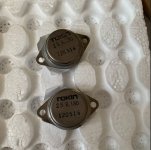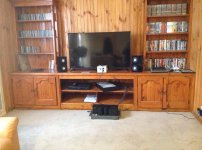In the past week I've purchased a Victor JM-S7 from Adelaide, a pair of used 2SK180s from China and a pair of KP926B VFETs from Russia. I am determined to get to the bottom of this matter and find out what the fuss is all about.
Back in 1977 I recall my good friend and mentor Allen Wright (RIP 2011) telling me that he'd love to design with a new type of transistor, but that they weren't available to the average person. I now believe he was talking about VFETs.
So, this pair is for you, Allen. And since you were rarely wrong, I expect to be delighted with the results.
Back in 1977 I recall my good friend and mentor Allen Wright (RIP 2011) telling me that he'd love to design with a new type of transistor, but that they weren't available to the average person. I now believe he was talking about VFETs.
So, this pair is for you, Allen. And since you were rarely wrong, I expect to be delighted with the results.
Attachments
results for zillion different arrangement are posted around
study them, then conclude than you wasted money and give them to first Greedy Boy in line

study them, then conclude than you wasted money and give them to first Greedy Boy in line

results for zillion different arrangement are posted around
study them, then conclude than you wasted money and give them to first Greedy Boy in line

Hahahaha. You're a funny girl. 😀
The Victor JM-S7 arrived this morning, all 20 kg of it. I had to use a trolley to move it into the livingroom because I couldn't lift the parcel. But OMFG! what an amplifier. Here are my impressions:
System: Unmolested Oppo UDP-203 -> teflon interconnects -> Victor JM-S7 -> single-core silver-plated copper speaker leads into two pairs of Jordan J6T cubes, no filtering for bass. Obviously the speakers are not capable of covering anything below 120 Hz or so, and I'm limited by the amount of power I can run into them. My inspiration to finish the enclosures for the Eikonas has just grown immensely.
Source material: Random cuts from very well known favourites. I have yet to play any SACD, HDCD or works that I had a hand in either recording or mastering.
High points: Solidity (I can't speak of bass authority with these speakers, but I'm feeling that it's there). Dynamic range - this is one area that I've always felt was missing in most equipment in comparison with live music, but the Victor has it in spades. Sophisticated balance. Lack of the usual masking by IMD and other rubbish.
Low points: There are a number of areas where I feel it could be improved but hey, it is a 1974 design after all. It's masked by smearing from global NFB, and I can definitely hear the capacitors in the signal path. But it is what it is, and I'm not planning to modify it.
Interesting points: This amplifier makes all the tiniest quirks in the system immediately and individually obvious. Example: I had been trying for days to figure out why I was getting distortion with the NAD 3020. The Victor led me immediately to a loose speaker terminal.
Comparisons, from memory: It doesn't have the dark background of the 300W Crown and yet it's absolutely quiet back there. It doesn't have the "pink overlay" of the Ongaku. It does have the "big power supply cap" feel of the RME 80+80.
Rankings:
Absolute sound quality: #2, beaten by the Vacuum State DPA300B monoblocks.
Practicality: Are you kidding me? It weighs a ton as is made from unobtainium.
Liveability: #1, the best amplifier I'll likely ever buy. And even if I had the VS monoblocks, they aren't beefy enough for much of the music I listen to, so I'd still need it. 🙂
Last word: 100+100 watts (into 8 ohms) of pure pleasure. From now on, I only live vicariously through myself. 😀
Now listening to: Tananas - Unamunacua. AND LOVING IT.
System: Unmolested Oppo UDP-203 -> teflon interconnects -> Victor JM-S7 -> single-core silver-plated copper speaker leads into two pairs of Jordan J6T cubes, no filtering for bass. Obviously the speakers are not capable of covering anything below 120 Hz or so, and I'm limited by the amount of power I can run into them. My inspiration to finish the enclosures for the Eikonas has just grown immensely.
Source material: Random cuts from very well known favourites. I have yet to play any SACD, HDCD or works that I had a hand in either recording or mastering.
High points: Solidity (I can't speak of bass authority with these speakers, but I'm feeling that it's there). Dynamic range - this is one area that I've always felt was missing in most equipment in comparison with live music, but the Victor has it in spades. Sophisticated balance. Lack of the usual masking by IMD and other rubbish.
Low points: There are a number of areas where I feel it could be improved but hey, it is a 1974 design after all. It's masked by smearing from global NFB, and I can definitely hear the capacitors in the signal path. But it is what it is, and I'm not planning to modify it.
Interesting points: This amplifier makes all the tiniest quirks in the system immediately and individually obvious. Example: I had been trying for days to figure out why I was getting distortion with the NAD 3020. The Victor led me immediately to a loose speaker terminal.
Comparisons, from memory: It doesn't have the dark background of the 300W Crown and yet it's absolutely quiet back there. It doesn't have the "pink overlay" of the Ongaku. It does have the "big power supply cap" feel of the RME 80+80.
Rankings:
Absolute sound quality: #2, beaten by the Vacuum State DPA300B monoblocks.
Practicality: Are you kidding me? It weighs a ton as is made from unobtainium.
Liveability: #1, the best amplifier I'll likely ever buy. And even if I had the VS monoblocks, they aren't beefy enough for much of the music I listen to, so I'd still need it. 🙂
Last word: 100+100 watts (into 8 ohms) of pure pleasure. From now on, I only live vicariously through myself. 😀
Now listening to: Tananas - Unamunacua. AND LOVING IT.
Attachments
Last edited:
A trolley? 20 kg. is not that heavy ;-)
No, even my female postie could lift it. But I'm 68 and have an umbilical hernia that hasn't yet been repaired. Covid shutdown sort of interefered with that. :/
Oh, also a correction to that review. "RME 80+80" should read "ME 80+80." RME are, of course, a German company that makes sound cards for computers, whilst ME is (was?) an Australian hi-fi manufacturer.
Last edited:
Just bought the alumin(i)um extrusions for the 2SK180 and KP926B builds. I was surprised to find that it can be bought off Ebay in Australia.
Since the 300W 125V lamps aren't available here I'll be using an alternative arrangement that may amuse some of you, more to come later once parts arrive.
Since the 300W 125V lamps aren't available here I'll be using an alternative arrangement that may amuse some of you, more to come later once parts arrive.
...my good friend and mentor Allen Wright (RIP 2011) ...
I counted him smong those too. We never talked about these, but if Allen was going to play with VFETs i’d really like to se ewhat he would have come up with.
Likely wildly different than what Nelson has done, but likely every bit as good.
dave
Whatever I design with those VFETs will be made with the intent of doing Allen proud. It may not be a Pass killer but I'll do my very best. The first steps were to assemble:
0. A stable living arrangement - DONE
1. An adequate reference system - DONE
2. Reference study materials - DONE (years ago)
3. Reference listening materials - DONE
4. The necessary parts - IN PROGRESS
0. A stable living arrangement - DONE
1. An adequate reference system - DONE
2. Reference study materials - DONE (years ago)
3. Reference listening materials - DONE
4. The necessary parts - IN PROGRESS
haiqu, sounds like a list of aspirations for us all! I’m curious about your KP926B. I also recently purchased some on eBay. I’m questioning their authenticity as the print on the transistors looks fairly new compared to the transistors themselves. Would you mind posting a few photos of you have them handy?
Those aspirations never waned, and part 0 was finally achieved last year at the age of 67. Hang in there!
If I did provide photos they would just be from the ad since they haven't yet arrived. However, they did look like old and authentic parts to me. The vendor had about twenty for sale, I got the last pair.
If I did provide photos they would just be from the ad since they haven't yet arrived. However, they did look like old and authentic parts to me. The vendor had about twenty for sale, I got the last pair.
Last edited:
How big is the gap?Rankings:
Absolute sound quality: #2, beaten by the Vacuum State DPA300B monoblocks.
How big is the gap?
Apples and oranges comparison I'm afraid. Allen was running vinyl at the time, whereas I gave all my records to my daughter and went fully digital 25 years ago when I designed an HDCD DAC. My impression of his overall system was that he was streets ahead of everything, but to my ears it lacked dynamics. But then again it may just have been so clean that the usual distortion wasn't there to make the peaks sound louder.
We both use Jordan speakers, so that can't be the issue, and in fact I contributed to the design of his interconnects so that's out as well. Those 300B toobs just sang, man.
- Home
- Amplifiers
- Pass Labs
- Haiqu joins the dork side of the farce

